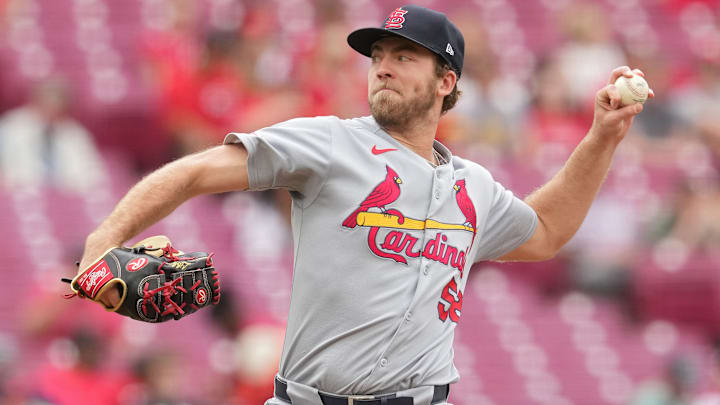Prospect growth is rarely, if ever, linear. While some players can fly through the minor leagues without struggling, others take time to refine their craft and adjust at each level. Former top prospects fizzle out all of the time in the majors, while non-descript 28-year-old players can come up in the majors and rake with nary a frustration.
St. Louis Cardinals starting pitcher Matthew Liberatore has seen a bit of everything.
Liberatore was acquired by the Cardinals via trade in January 2020. St. Louis sent power-hitting right handed Jose Martinez and a 25-year-old outfield prospect by the name of Randy Arozarena to the Tampa Bay Rays. In exchange, the Cardinals received 2018 first-round draftee Liberatore, the #41 overall prospect at the time according to MLB Pipeline.
At the time, this trade seemed like a good one. The Cardinals shed some outfield depth to make room for players like Harrison Bader, Dexter Fowler, Lane Thomas, and Tyler O'Neill. They received one of the game's top pitching prospects at the time in return.
Initial returns on the trade heavily favored the Rays. Randy Arozarena won the American League Rookie of the Year in 2021, he consistently posted plus offensive numbers, and he was a driving force in the 2020 playoffs, winning the ALCS MVP that year. Meanwhile, Liberatore, who is five years younger than Arozarena, was toiling in the minors trying to find his niche.
Liberatore spent most of his 2021 and 2022 seasons in Triple-A Memphis. He failed to post an ERA below 4.00 as a starting pitcher in either of those years. He made his MLB debut in 2022, and he had a 5.97 ERA across nine appearances (seven starts). His 2023 season in the majors was only marginally better, as he finished with a 5.25 ERA across 22 appearances (11 starts).
2024 came around, and Matthew Liberatore began finding where he could thrive: the bullpen. Libby made 60 appearances last year, and he posted a 3.69 ERA in 63.1 innings of relief. His stats across the board were significantly better in relief than they were as a starter, and many believed that he had found his role as a multi-inning, high-leverage reliever.
However, the Cardinals had other plans.
The club planned on using 2025 as a season to see what their former top prospects could provide and if they were pieces for the future. Matthew Liberatore, being a former top prospect in all of baseball, was included in that group, and he was chosen as the club's fifth starter out of spring training. He was finally getting his uninterrupted shot to seize a rotation spot for the foreseeable future.
Liberatore has done nothing but post every five days since.
Matthew Liberatore's massive improvements this year have made a once-failed trade into a more balanced one for John Mozeliak.
Matthew Liberatore has a 3-3 record through seven starts and 41 innings. He has a 3.07 ERA, a 2.31 FIP, and he's struck out 23.8% of the batters he's faced. His 20% K-BB rate ranks 17th among qualified starters, and his six total walks are just the third-fewest among qualified starting pitchers. Libby has been one of the best pitchers in baseball to start the year.
Matthew Liberatore's 6th and 7th Ks thru 5. pic.twitter.com/hATr2uDaZU
— Rob Friedman (@PitchingNinja) May 7, 2025
This is great news for both Liberatore and the Cardinals. St. Louis could be looking at its first homegrown starting pitcher since Jack Flaherty, and Liberatore is building his case to be a legitimate top-of-the-rotation arm. What's different for the southpaw in 2025?
Liberatore has opted to use his cutter and changeup more frequently at the sacrifice of his four-seam fastball and slider. His cutter usage is up 1.1%, and his changeup is being thrown nearly 8% more than last year. This is good, as his changeup is seeing more induced horizontal break than it did last year. He's also seen an uptick in velocity on his changeup from 87.9 MPH to 89.1 MPH.
Libby has also opted to use his cutter more often as a put-away pitch. Its 14.3% put-away rate is up nearly 8% from last year. He's improved this pitch by using its horizontal break more than he did in the past, as it's movement is up 1.6 inches in glove-side movement. Batters went from hitting .432 against his cutter last year to just .235 this year. This improved cutter has also helped his fastball play up.
Right-handed batters have hit Liberatore much better throughout his career. They have posted a .276/.342/.473 slash line against him, but he's actually flipped his success this year with reverse splits. This year, righties are slashing only .210/.223/.319 against him compared to .229/.308/.257 for left-handed hitters.
Matthew Liberatore has used his four-seamer less often against righties this year, and he's swapped it out for greater changeup usage. Right-handed hitters are hitting just .118 against his changeup this year. He's also used his sinker far less often against right-handed hitters, dropping its usage nearly 7% compared to last year.
Matthew Liberatore used his changeup 19.7% of the time vs. RHB last night.
— Kareem (@KareemSSN) April 8, 2025
In his season debut against the Angels, he had used it only 4.2% in those matchups. pic.twitter.com/YNMa4lxCWt
Matthew Liberatore's revamped pitch profile has allowed him to flourish in 2025. He's finally balancing out a trade that once favored the Tampa Bay Rays, and his success this year should propel him to being a consistent rotation force for the Cardinals over the next three years.
